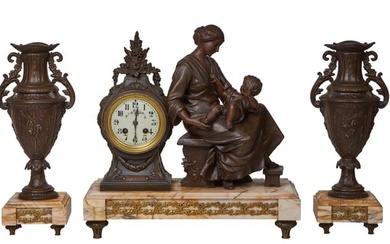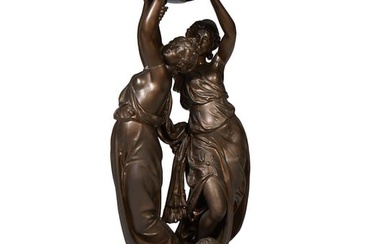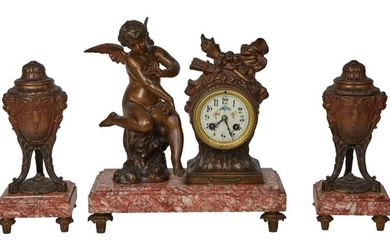A FRENCH PATINATED SPELTER AND GILT BRASS MOUNTED BELGE NOIR MARBLE FIGURAL MYSTERY MANTEL CLOCK
A FRENCH PATINATED SPELTER AND GILT BRASS MOUNTED BELGE NOIR MARBLE FIGURAL MYSTERY MANTEL CLOCKAndre Romain Guilmet, Paris, late 19th century The circular countwheel bell striking movement with Guilmet`s crank and stirrup escapement connected via fixed crutch passing through the movement plates to a cylindrical steel post resting on pin pivot and carrying the moulded plinth for the figure surmount, the backplate stamped with oval GLT, BREVETTE, S.G.D.G. trademark and numbered 1678, the 4 inch gilt on black marble circular Roman numeral dial with gilt spade hands set behind egg-and-dart cast hinged bevel-glazed bezel, the rectangular plinth-form case with 'bronze' patinated spelter figural surmount cast as a standing Classical female holding aloft in her right hand the spring suspension for the glass inset bob pendulum above cavetto moulded top and strapwork scroll cartouche cast gilt side handles, the front with incised gilt scroll decorated infill around dial, on generous cavetto moulded skirt base with conforming decoration to front over scroll cast lions paw feet with scroll cast pendant apron between to front.71cm (28ins) high, 37cm (14.25ins) wide, 24cm (9.5ins) deep. Provenance: The Selwyn Demmy Collection. Andre Romain Guilmet (born on the 10th of December 1827 in La Ferte-Gaucher, France) was amongst a number of French clockmakers, including Robert Houdin, who responded to the nineteenth century Parisian passion for magic and conjuring by designing a clock which was inherently mysterious in nature. The mechanism which he devised was designed to give the impression that the pendulum, held by the figural surmount, appeared to oscillate without and impulse. This was achieved by standing the figure on a post which was pivoted on a pinpoint at the base, this allowed the figure itself to oscillate side to side imperceptibly. With this post connected to the specially designed escapement the impulse for the pendulum is ingeniously transferred through the figure. Guilmet was granted Patent for his invention in 1867, which was modified on 1872. The apparent popularity for his design of `Pendule a marche mysterieuse` can in part be due to the showing of such clocks at the various international exhibitions held in Paris and elsewhere throughout the latter quarter of the 19th century.Condition Report: Movement is in relatively clean working condition with no visible evidence of alteration or significant replacements. The dial is free from visible damage and appears to retain original gilding to the hands and incised numerals. The case is also generally in fine original condition with the figure being free from visible damage and repair and retaining its original 'bronze' patination in fine condition. The marble has a small chip to the upper left hand projection and another larger chip/loss to the lower edge of the skirt where the marble butts up to the front left hand foot. Otherwise damage to marble is limited to a few other small edge chips and light grey blooming to the surface. The gilding to the brass handle and mounts also has some noticeable historic wear. Overall generally a fine example in good original untouched condition.Clock has pendulum and a winding key. Condition Report Disclaimer
[ translate ]Sale price
Estimate
Time, Location
Auction House
A FRENCH PATINATED SPELTER AND GILT BRASS MOUNTED BELGE NOIR MARBLE FIGURAL MYSTERY MANTEL CLOCKAndre Romain Guilmet, Paris, late 19th century The circular countwheel bell striking movement with Guilmet`s crank and stirrup escapement connected via fixed crutch passing through the movement plates to a cylindrical steel post resting on pin pivot and carrying the moulded plinth for the figure surmount, the backplate stamped with oval GLT, BREVETTE, S.G.D.G. trademark and numbered 1678, the 4 inch gilt on black marble circular Roman numeral dial with gilt spade hands set behind egg-and-dart cast hinged bevel-glazed bezel, the rectangular plinth-form case with 'bronze' patinated spelter figural surmount cast as a standing Classical female holding aloft in her right hand the spring suspension for the glass inset bob pendulum above cavetto moulded top and strapwork scroll cartouche cast gilt side handles, the front with incised gilt scroll decorated infill around dial, on generous cavetto moulded skirt base with conforming decoration to front over scroll cast lions paw feet with scroll cast pendant apron between to front.71cm (28ins) high, 37cm (14.25ins) wide, 24cm (9.5ins) deep. Provenance: The Selwyn Demmy Collection. Andre Romain Guilmet (born on the 10th of December 1827 in La Ferte-Gaucher, France) was amongst a number of French clockmakers, including Robert Houdin, who responded to the nineteenth century Parisian passion for magic and conjuring by designing a clock which was inherently mysterious in nature. The mechanism which he devised was designed to give the impression that the pendulum, held by the figural surmount, appeared to oscillate without and impulse. This was achieved by standing the figure on a post which was pivoted on a pinpoint at the base, this allowed the figure itself to oscillate side to side imperceptibly. With this post connected to the specially designed escapement the impulse for the pendulum is ingeniously transferred through the figure. Guilmet was granted Patent for his invention in 1867, which was modified on 1872. The apparent popularity for his design of `Pendule a marche mysterieuse` can in part be due to the showing of such clocks at the various international exhibitions held in Paris and elsewhere throughout the latter quarter of the 19th century.Condition Report: Movement is in relatively clean working condition with no visible evidence of alteration or significant replacements. The dial is free from visible damage and appears to retain original gilding to the hands and incised numerals. The case is also generally in fine original condition with the figure being free from visible damage and repair and retaining its original 'bronze' patination in fine condition. The marble has a small chip to the upper left hand projection and another larger chip/loss to the lower edge of the skirt where the marble butts up to the front left hand foot. Otherwise damage to marble is limited to a few other small edge chips and light grey blooming to the surface. The gilding to the brass handle and mounts also has some noticeable historic wear. Overall generally a fine example in good original untouched condition.Clock has pendulum and a winding key. Condition Report Disclaimer
[ translate ]






